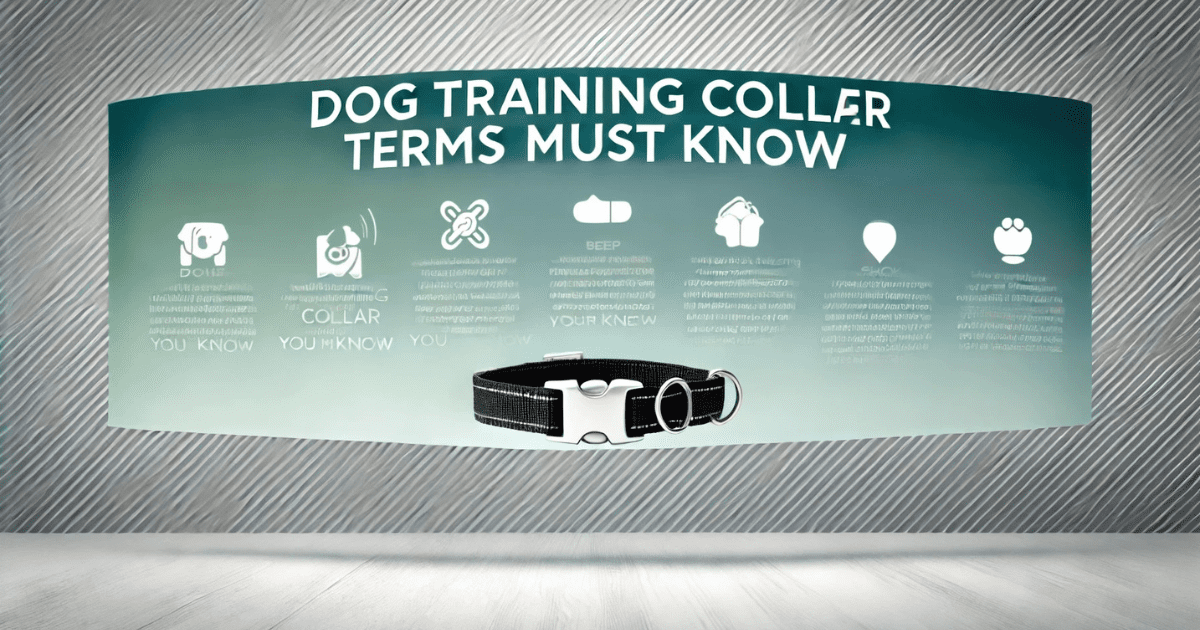🔔 Introduction
Listen up: If you’re serious about dog training, you need to know these dog training terms cold. I’ve seen too many good people fail because they don’t understand these crucial concepts. Let’s fix that right now.

📚 Table of Contents: Dog Training Terms For Collars YOU Must Know NOW!
🎯 Stimulation Levels
What the marketing folks won’t tell you: “Stimulation” isn’t just a fancy word for shock. It’s a controlled static pulse ranging from a gentle tap to a firm correction. Think of it like tapping someone’s shoulder—you can do it softly to get attention or firmly if they’re about to step into traffic. Learn about top-rated options in our Best Dog Training Collar for Stubborn Dogs.
🔌 Contact Points
Here’s the truth about those metal prongs on training collars: they’re not torture devices. These contact points are communication tools that need to touch your dog’s skin (not fur) to work. Get this wrong, and you might as well throw your money in a ditch.
⚡ Static Correction
Stop calling it a shock—that’s dead wrong. Static correction is more like the zap you get from carpet static. It’s startling but not painful when used correctly. Don’t let anyone tell you different.
💧 IPX7 Rating
Warning: Skip this detail; your expensive collar might die in the rain. IPX7 means your collar can survive in 3 feet of water for 30 minutes. Anything less? Keep your wallet closed.
🎚️ Rheostat Dial
Most folks have no clue what this means, but it’s a game-changer. This dial lets you fine‑tune corrections like a volume knob instead of jumping between preset levels. It’s the difference between whispering and shouting.
📡 E-Collar
Not to be confused with those plastic cones of shame! An e-collar (electronic collar) is a remote training tool. The “e” stands for electronic, not evil—despite what some might tell you.
🌊 DryTek Technology
Here’s something most retailers won’t explain: DryTek is more than just fancy marketing. It’s a specific waterproofing method that keeps your collar working even after your dog’s hundredth swim in the lake.
⏱️ Continuous vs. Momentary Stimulation
The secret sauce of proper training: momentary is like a quick tap, and continuous is like holding that tap. Use the wrong one, and you’ll wonder why your stubborn pup isn’t listening.
📏 Working Range
Don’t fall for the marketing trap: “maximum range” isn’t what matters. Working range is what your collar can do with trees, buildings, and other obstacles in the way—it’s a big difference.
🔄 Training Modes
Beep, vibrate, static—each mode has its place. But here’s what the manual won’t tell you: different dogs respond better to different modes. Brush up on comparisons in our Best Dog Training Collars for Every Breed and Behaviour.
🔒 Security Keypad Lock
Think this is just a fancy extra? Wrong. This feature prevents accidental corrections that could set your training back weeks. Skip this, and you might regret it.
📈 Correction Intensity
Listen closely: higher numbers don’t mean better training. Correction intensity is about finding the perfect level where your dog notices but isn’t stressed. Too many folks get this wrong.
🚨 Critical Safety Rules
Let me be crystal clear: these aren’t suggestions—they’re non‑negotiable rules that separate successful trainers from those who waste time and money. Skip these dog training terms, and you might as well set your training budget on fire.
12‑Hour Rule
Here’s a $500 mistake waiting to happen: leaving a training collar on too long. That collar needs to come off after 12 hours, period. Example: if you start at 7 AM, take it off by 7 PM—no exceptions.
Pressure Points
Warning: skip checking these, and you’ll turn a training session into a vet visit. Run your fingers around contact areas—if you feel warmth or irritation, adjust the fit.
Lowest Stimulation Level
Start at zero and work up, not down. Find the level where your dog’s ear twitches or head turns slightly—that’s your sweet spot.
Collar‑Free Breaks
Think of it like taking off your shoes after a long day—your dog needs relief too. Remove the collar during meals, sleep, and downtime.
🔧 Behaviour Fixes
- Stop Leash Pulling: Teach your dog that pulling gets them nowhere while a loose leash means forward progress.
- End Fence Fighting: When your dog sees another dog, they look at you instead of launching World War III.
- Control Excessive Barking: Neighbours shouldn’t know every time a leaf falls in your yard.
- Prevent Running Off: Your dog stays in your unfenced yard because they choose to, not because they have to.
🔀 Mix-and‑Match Training
Clicker + Collar Training
Click and treat for coming when called, gentle collar reminder if they ignore you.
Treat Rewards + Collar Cues
Use treats to reward position and a collar to remind them—never both at once.
Verbal Praise + Gentle Corrections
A happy voice for right choices, a calm correction for mistakes—no drama, just consistency.
💡 Conclusion
Remember: these aren’t just definitions, they’re your road map to success. Skip understanding any of these dog training terms, and you’re asking for trouble. Master these dog training terms, and you’ll have the well-behaved dog you’ve always dreamed about.
Affiliate Disclosure: As an Amazon Associate, I earn from qualifying purchases. Links may earn a commission at no extra cost to you. See our Affiliate Disclosure for details.